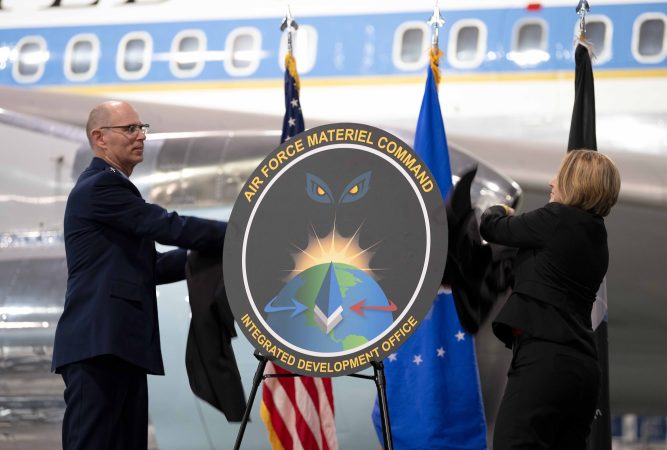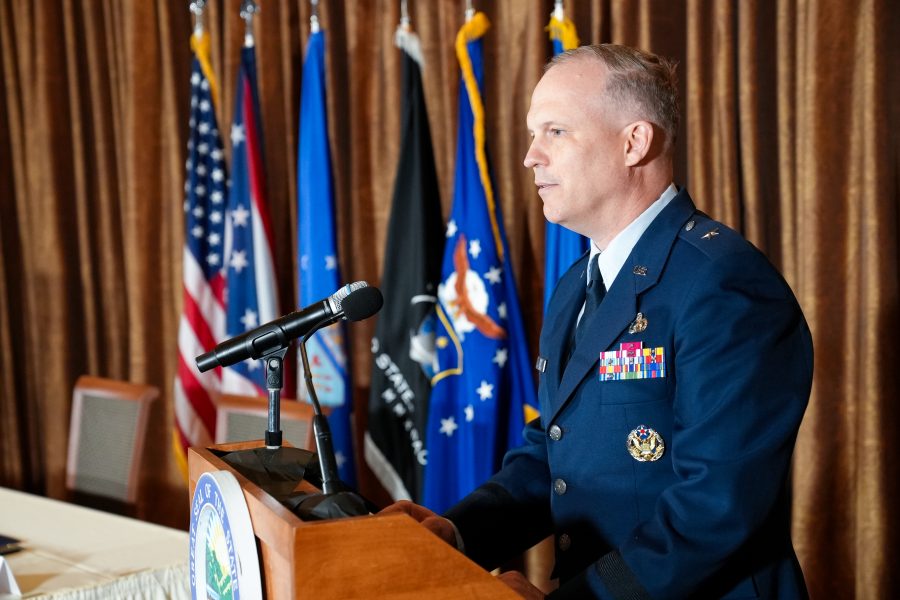The Air Force is finally poised to deal with the “Valley of Death” problem—the gulf between the invention of an innovative new technology and its deployment at scale to warfighters— leaders of the department’s science and technology enterprise told defense industry executives Aug 27.
New organizations like the provisional Integrated Capabilities Command and the Air Force Materiel Command Integrated Development Office are looking not at exciting new technologies that are emerging, but at operational problems that need solving, said Air Force Deputy Assistant Secretary for Science, Technology, and Engineering Janet Wolfson. She spoke at a panel discussion during the National Defense Industrial Association’s Emerging Technology Conference.
Traditionally, the Air Force has thought of—and purchased—capabilities on a per-platform basis: Buying aircraft, missiles or other equipment.
But the new organizations are looking not at platforms, but at “mission threads”—the sequence of capabilities required to execute a particular mission. They are thus able to identify key bottlenecks, roadblocks and missing capabilities, Wolfson said.
“They’re really laying out how solving this one problem, here’s all the things that it can fix,” she told Air & Space Forces Magazine in a brief interview after the panel, “Think of it like Pick-up Sticks. If I pull the right one, all the others move too.”
But identifying key missing capabilities is only half of the solution, she added. “Getting that buy-in from Pentagon headquarters to help us … fund them” is also essential, she said, “And that’s what I’m optimistic about.”
The new administration has given reformers a mandate of sorts, she said, “We can break stuff, and throw out bad processes.” But the breakthrough was the fruit of many years’ work, she added. “This is something that has been working through the Air Force for a long time. … It just takes time to really formulate how to go after these complicated things.”
Looking at mission threads end-to-end to identify capability gaps and problems is the key change, explained Brig. Gen. Matthew Groves, the director of capability development for the ICC.
“In the past, you might have seen capabilities that were developed within Air Force stovepipes, within Air Combat Command or Air Mobility Command. And those were never integrated together until they got to a fairly high level in the process,” he told reporters after the panel. One example of a stovepiped capability proffered later by an industry executive who was not authorized to speak to the media was F-22 communications. The fifth-generation fighter was initially developed without much thought being given to how it would communicate with other platforms, leading to problems later on.
ICC, Groves added, is intended to “create that collaborative and integrated approach from the beginning to ensure that we are not just developing some shiny new thing that goes 10 percent faster, but rather working on the entire mission set.”
The idea, he said, is to combine “our requirements work, our capabilities, development, and our resource recommendations together so that when an industry partner or an S&T lab has an idea, they can actually see the whole path from prototype to product,” from the first research contract to a program of record.
“That’s how we avoid innovations rusting in a warehouse and instead deliver real, scalable, interoperable, joint fighting capabilities,” he said.
ICC, as designed, is meant to absorb different requirements roles that belonged to Air Combat Command, Air Force Global Strike Command, and Air Mobility Command, centralizing the process of buying cutting-edge technology in a single organization.
Priority areas for the ICC “include, but are not limited to, [Command, Control and Computers, or] C3, cyber warfare and autonomous systems,” Groves told the panel.
The ICC, initially stood up in a provisional capability last September, has been in limbo for six months. In February, Defense Secretary Pete Hegseth directed the Department of the Air Force to pause work on the ICC and other changes planned in 2024 as part of then-Secretary Frank Kendall’s “Re-Optimization for Great Power Competition” initiative. Officials said this was to give the department’s then-unconfirmed new leadership, Secretary Troy E. Meink and Undersecretary Matthew Lohmeier, the chance to review the plans.
Meink was sworn in May 16 and Lohmeier in July, but there is still no word on the future of the ICC, Groves said, adding that though he had not personally met the new secretary, “I know that [he] is very well informed about everything we’re doing.”
He said the uncertainty over the future was not a problem for the ICC: “We’re pushing forward with the work that needs to be done.”
A big piece of that work is creating a clear, unified “demand signal” for industry, plainly identifying the breakthrough capabilities the department sought, said Lorenzo Vallone, the technical director of the Integrated Development Office in Air Force Materiel Command, the procurement shop that buys most enterprise software and other IT for the department.

IDO was created to be the procurement counterpart to the requirements work done by ICC, and the two are working together to ensure industry gets a single unified demand signal, Vallone said. The two organizations have already held joint industry days and are working on a white paper “to come out shortly here in the near future.”
The paper will focus on “emerging disruptive technologies,” he added. “We’re looking at advanced materials and manufacturing. We’re looking at directed energy or scalable non kinetic capabilities … AI and machine learning, human-machine teaming, and machine-to-machine learning. We’re looking, of course, at autonomous and unmanned systems, and interoperability between autonomous and manned systems. We’re looking at the integration of the air and space domains, and that’s about policy in that area. And lastly, we’re looking at hypersonics and counter-hypersonics, with regards to weapons and vehicles.”
To succeed in eliminating the Valley of Death, it is critical that requirements generation, research, resource allocationm and procurement are all in lockstep, said Air Force Research Laboratory Commander Brig. Gen. Jason Bartolomei. Program Executive Officers who manage the big acquisition programs the department runs, are at the coalface, he said—they are the ones who have to actually execute on the new vision.
“This panel is great,” Bartolomei said, “What would have been perfect, is if we had the 20 PEOs sitting up here.”
PEOs are stepping up, he added, “One of the things that we’re seeing that is really encouraging is innovation-friendly acquisition portfolios,” he said, singling out the program office for Command, Control, Computers and Battle Management. Acquisition leaders like C3BM PEO Maj. Gen. Luke Cropsey are “really leaning forward” with a modular open systems approach that sets hardware and software standards to ensure that, for example, a radar targeting system designed by one vendor can talk to a remotely guided missile designed by another. “They’re growing the ecosystem for the vendors in those acquisitions to be able to be more nimble,” he said.
Other PEOs were developing, in partnership with industry, a blueprint called a government reference architecture, a core set of rules and interfaces that vendors have to follow to ensure interoperability between their solutions, explained Bartolomei.
He compared the architecture and the more mature technologies designed to meet its requirements to a Christmas tree, and the cutting-edge technologies being developed by AFRL and elsewhere to its ornaments. “We can hang different ornaments on that Christmas tree, and they can be more potent and more effective,” he said.
He cited the old adage that “technology oftentimes doesn’t know its application until that moment,” appealing to industry to respond to the demand signal. “I think you and your teammates might be sitting on things that we [in the military] haven’t even discovered,” he said. “And that excites me.”


